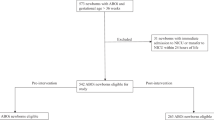Abstract
Objective:
(1) To determine whether infants born to O+ mothers who had selective cord-blood testing would have higher rates of clinically significant hyperbilirubinemia compared with those newborns who had routine cord-blood testing. (2) To determine the amount of cost savings by implementing a policy of selective cord-blood testing in newborns born to O+ mothers.
Study Design:
We conducted a retrospective pre/post intervention chart review on all infants in the normal newborn nursery at Loyola, born to blood type O+ women between 1 April 2008 and 1 April 2009. The pre-intervention group (routine testing) included infants born within 6 months before implementation of a new policy. The post-intervention group (selective testing) included infants born within 6 months following the implementation of a new policy. Data were collected for each of these groups regarding clinically significant hyperbilirubinemia.
Result:
All 250 of the infants in the routine testing group had a cord-blood type and Coombs done, whereas 42 of 164 (25%) infants in the selective group had testing done. By the end of the 6 months following the policy change, only 8% of infants were undergoing cord testing. When comparing routine vs selective testing, there was no statistically significant difference in the 24-h serum bilirubin, rate of phototherapy during the birth hospitalization, rate of readmission for hyperbilirubinemia or peak serum bilirubin level at readmission. The 92% reduction of cord-blood typing and Coombs testing would lead to a cost saving of $4100 per year to our hospital and $18 900 per year to our patients, and 95 h per year of technician time to perform these tests. When extrapolated to Illinois births in 2008, this would lead to an annual cost saving of almost $800 000 to Illinois hospitals and about $3.6 million to patients.
Conclusion:
Selective newborn cord testing of infants born to O+ mothers can decrease the use of resources and costs without increasing the risk of clinically significant hyperbilirubinemia.
This is a preview of subscription content, access via your institution
Access options
Subscribe to this journal
Receive 12 print issues and online access
$259.00 per year
only $21.58 per issue
Buy this article
- Purchase on Springer Link
- Instant access to full article PDF
Prices may be subject to local taxes which are calculated during checkout
Similar content being viewed by others
References
Maisels M . Neonatal jaundice. Pediatr Rev 2006; 27 (12): 443–454.
Walker RH (ed). Blood Bank Technical Manual, 11th edn. American Association of Blood Banks: Bethesda, MD, 1993, pp 204–229.
Sarici SU, Yurdakök M, Serdar MA, Oran O, Erdem G, Tekinalp G et al. An early serum bilirubin measurement is useful in predicting the development of significant hyperbilirubinemia and severe ABO hemolytic disease in a selective high risk population of newborns with ABO incompatibility. Pediatrics 2002; 109 (4): e53.
Mollison PL, Klein HG, Anstee DJ. Blood Transfusion in Clinical Medicine, 9th edn. Blackwell Scientific Publications Inc: Boston, Mass, 1993, pp 543–591.
AAP Subcommittee on Hyperbilirubinemia. Management of hyperbilirubinemia in the newborn infant 35 or more weeks of gestation. Pediatrics 2004; 114 (1): 297–316.
Judd WJ . Practice Guidelines for prenatal and perinatal immunohematology, revisited. Transfusion 2001; 41 (11): 1445–1452.
Leistikow EA, Collin MF, Savastano GD, de Sierra TM, Leistikow BN . Wasted health care dollars: routine cord blood type and Coombs’ testing. Arch Pediatr Adolesc Med 1995; 149 (10): 1147–1151.
Bhutani VK, Johnson L, Sivieri EM . Predictive ability of a predischarge hour-specific serum bilirubin for subsequent significant hyperbilirubinemia in healthy term and near term newborns. Pediatrics 1999; 103: 6–14.
Madlon-Kay DJ . Identifying ABO incompatibility in newborns: selective vs automatic testing. Journal of Family Practice 1992; 35 (3): 278–280.
Eggert LD, Wiedmeier SE, Wilson J, Christensen RD . The effect of instituting a prehospital discharge newborn bilirubin screening program in an 18-hospital health system. Pediatrics 2006; 117 (5): e855–e862.
Mah MP, Clark SL, Akhigbe E, Englebright J, Frye DK, Meyers JA et al. Reduction of severe hyperbilirubinemia after institution of predischarge bilirubin screening. Pediatrics 2010; 125 (5): e1143–e1148.
Acknowledgements
We thank Kelly Dorsey, MD, Karen Cavanaugh, MD, and Julie Holt for their help in data collection. We also acknowledge Regina Harders, PhD, for her statistical expertise.
Author information
Authors and Affiliations
Corresponding author
Ethics declarations
Competing interests
The authors declare no conflict of interest.
Rights and permissions
About this article
Cite this article
Shahid, R., Graba, S. Outcome and cost analysis of implementing selective Coombs testing in the newborn nursery. J Perinatol 32, 966–969 (2012). https://doi.org/10.1038/jp.2012.26
Received:
Revised:
Accepted:
Published:
Issue Date:
DOI: https://doi.org/10.1038/jp.2012.26
Keywords
This article is cited by
-
Predicting Significant Hyperbilirubinemia in ABO Incompatibility: Is Cord Direct Antiglobulin Test Useful?
Indian Journal of Hematology and Blood Transfusion (2022)
-
Routine blood typing and DAT in infants of group O mothers
Journal of Perinatology (2013)



